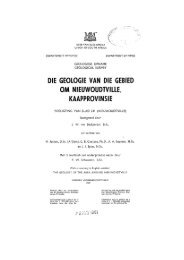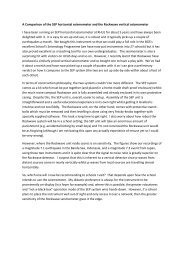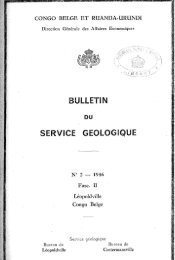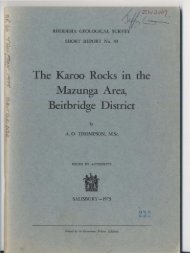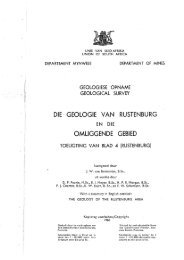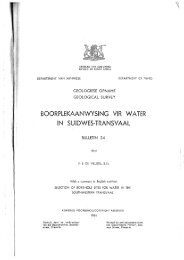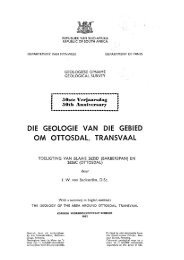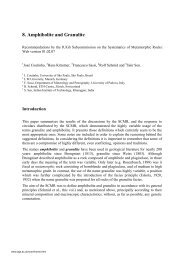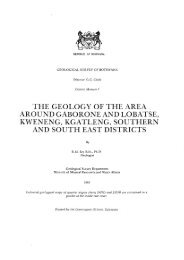Bibliography - British Geological Survey
Bibliography - British Geological Survey
Bibliography - British Geological Survey
You also want an ePaper? Increase the reach of your titles
YUMPU automatically turns print PDFs into web optimized ePapers that Google loves.
Doyle, J. C. & Costello, P. 1987. The letter Science 83 refused to print. Baker Street Miscellanea, no. 49,<br />
35–37. (This letter, from Dame Jean Conan Doyle, had been prompted by an article in the journal Science 83<br />
by John Winslow, which accused her father, Sir Arthur Conan Doyle, of having perpetrated the ‘hoax’ at<br />
Piltdown. She dismisses the article as ‘a piece of silly-season journalism, a mere frivolity.’ Addressed<br />
originally to the editor of Science 83, it was never published until taken up by the present journal.)<br />
Drawhorn, G. M. 1994. Piltdown: evidence of Smith-Woodward’s complicity. Paper presented in a poster<br />
session of the American Association of Physical Anthropologists on 1 April 1994 and reproduced in full on<br />
Richard Harter’s website. (Turrittin 2006, 28–29, states that the presentation was actually made on 31 Mar,<br />
not on April Fool’s Day!)<br />
Drawhorn, G. M. 1996. Piltdown. Pacific Discovery, 49 (4), 45. (A response to Anderson 1996)<br />
Drennan, M. R. 1927. A contribution to the Piltdown problem. Nature, 120 (17 Dec), 874. (The writer,<br />
based in the Anatomy Department, University of Cape Town, presents reasons for a new estimate of the<br />
cranial capacity of the Piltdown skull)<br />
Dubois, E. 1894. Pithecanthropus erectus: eine menschenaehnliche Uebergangsform aus Java. Batavia:<br />
Landesdruckerei, 39 pp, 2 plates. (Eugène Dubois believed that he had found the long sought after ‘missing<br />
link’ with his discovery in 1891 of an ape-like skullcap, a human-looking thighbone and two molar teeth on<br />
the banks of the Solo River in eastern Java, which he dated to the Pliocene. Yet doubts were soon expressed<br />
concerning the professed geological age and mutual relations of the finds. Some scientists considered the<br />
skullcap to belong to a giant gibbon, a view that Dubois himself appears at some stage to have entertained.)<br />
Dubois, E. 1896. On Pithecanthropus erectus: a transitional form between man and the apes. Scientific<br />
Transactions of the Royal Dublin Society, ser. 2, 6 (1), 1–18. (In this English language account of the Java<br />
find, the author emphasises the great age of the bones and teeth in stating that ‘Their colour is chocolatebrown;<br />
they are harder than marble, and very heavy.’ E. T. Newton (1897) was likewise struck by the ‘dark<br />
brown colour’ of the Java bones. One may suppose that the Piltdown forger was similarly impressed.)<br />
Duckworth, W. L. H. 1912 (contribution to discussion in Dawson & Woodward 1912. Philip Tobias, in<br />
Spencer 1990a, ix–x, records conversations with Duckworth, who claimed to have examined the Piltdown<br />
remains before the formal announcement in Dec1912, and ‘had spotted at once that the patina on the cranium<br />
and on the jaw differed. He had written volumes of unpublished observations and reflections on the Piltdown<br />
remains...’ Costello 1986 has implicated Duckworth in the Piltdown fraud on the basis of a rumour at<br />
Cambridge.)<br />
Durrenberger, E. 1965. More about Holmes and the Piltdown problem. Baker Street Journal, 15, 28‒31.<br />
Eastwood, T. & Oakley, K. P. 1953. [Presentation of the Henry Stopes Memorial Medal to Dr. K. P. Oakley<br />
in recognition of his work on the prehistory of Man.] Proceedings of the Geologists’ Association, 64 (1),<br />
50–51. (At the Annual General Meeting of the Society on 7 Mar 1952, the President, Tom Eastwood of the<br />
<strong>Geological</strong> <strong>Survey</strong>, presented Oakley with a medal, noting among other things that ‘In collaboration with the<br />
chemists of the Government Laboratory, you applied the fixation of fluorine in bones and teeth to the dating<br />
of the Swanscombe Skull, to the Galley Hill Skeleton―thus ending more than sixty years of controversy―<br />
and to the Piltdown Skull.’ Oakley in reply, acknowledging those who had given him encouragement, added<br />
‘Nor do I forget...how much I owe to the stimulus of working for a time on the <strong>Geological</strong> <strong>Survey</strong>, and thereby<br />
coming into contact with you and your colleagues. Especially would I like to mention Mr. Bromehead, who,<br />
in the course of my work on rock-phosphates during the war, led me to take an interest in the geological<br />
aspects of fluorosis, which had an unexpected outcome; and Mr. Henry Dewey, who introduced me to the<br />
Swanscombe gravels.’)<br />
Edmunds, F. H. 1926 (see under White, H. J. O.)<br />
Edmunds, F. H. 1950. Note on the gravel deposit from which the Piltdown skull was obtained. Abstracts of<br />
the Proceedings of the <strong>Geological</strong> Society of London, no. 1457, 39–40; reprinted in Quarterly Journal of the<br />
<strong>Geological</strong> Society of London, 103 (1), 133–134. (Charles Dawson stated, wrongly, that the Piltdown gravel<br />
is situated at 80 ft above the level of the River Ouse, whereas it is only at 50–55 ft. W. J. Sollas (1924, 183)<br />
took Dawson’s figure and converted it to 25 metres, and then equated the Piltdown terrace to the 30 m terrace<br />
of the Thames, thence drawing the deduction that the gravels are probably of Chellean age. ‘Thus was a 50-<br />
foot terrace elevated to a 30-metres, or 100-foot, terrace.’)



